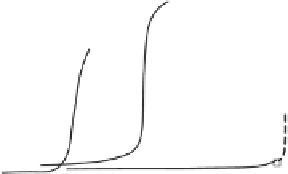Environmental Engineering Reference
In-Depth Information
matric suction of approximately 414 kPa during the test
(Fig. 11.29b). The second test was performed under
atmospheric air pressure conditions (i.e.,
u
a
=
30
Air blew through
the disk
0). The
stress versus strain curves from both compressions tests
showed essentially the same results up to the maximum
deviator stress and only differed slightly subsequent to the
peak strengths. In other words, the measured shear strength
remained essentially unaffected by the axis translation pro-
cedure. The results also illustrate that the pore-water in the
soil was able to withstand high tensions without rupturing.
Since the soil matric suction in both tests was about 414
kPa, the pore-water pressure in the second test specimen
would be -414 kPa gauge pressure or -313 kPa in terms
of absolute pressure.
25
Aerox 'Celloton' Vl
20
15
Air blew through
the disk
Doulton
grade P6A
10
Kaolin
-consolidated
and fired
5
0
0
50
100
150
200
250
300
350
Applied matric suction (
u
a
-
u
w
), kPa
Figure 11.30
Air passage characteristics of three high-air-entry
disks (after Bishop and Henkel, 1962).
11.4.2 Pore-Water Pressure Control and/or
Measurement
Pore-water pressures in an unsaturated soil specimen can
be controlled at a prescribed value when the water phase is
maintained under drained conditions during a shear strength
test (e.g., consolidated drained test). Pore-water pressures
can be measured when the water phase is maintained in
an undrained mode throughout the test (e.g., constant water
content or in a consolidated undrained test). The key element
that provides the separation between the pore-air and pore-
water pressures is the high-air-entry ceramic disk.
The high-air-entry disk acts as a semipermeable mem-
brane that separates the air and water phases. The sepa-
ration of the air and water phases can be achieved only
when the air-entry value of the disk is greater than the
matric suction of the soil. The air-entry value of the disk
depends on the maximum size of pores in the ceramic disk.
Figure 11.30 illustrates how air commences to flow through
the ceramic disks once a limiting air-water differential pres-
sure is applied across a ceramic disk. The theoretical maxi-
mum pore size for any air-water pressure differential can be
estimated using the capillary model.
in the ceramic are controlled by the preparation and sintering
process used to manufacture the ceramic disk. The smaller
the pore sizes in a disk, the larger will be the air-entry value.
The properties of high-air-entry disks manufactured by
Soilmoisture Equipment Corporation in Santa Barbara, Cal-
ifornia, are tabulated in Table 11.2. The disks are commonly
identified by the air-entry value of the ceramic disk and
are usually expressed in the unit of bars (i.e., 1 bar
=
100 kPa). The water coefficient of permeability of a disk can
be measured by mounting the disk in a triaxial apparatus and
placing water above the disk. The disk must be sealed on
the sides (i.e., around the perimeter) in order to prevent the
passage of water around its circumference. An applied air
pressure then produces a pressure gradient across the high-
air-entry disk. The volume of water flowing through the disk
can be measured using a water volume change indicator.
Table 11.2 High-Air-Entry Disks Manufactured by
Soilmoisture Equipment Corporation
u
a
−
u
w
d
=
2
T
s
R
s
(11.31)
Range of
Air-Entry
Approximate Coefficient of
Values,
where:
u
a
−
u
a
−
u
w
d
Pore Diameter
Permeability,
u
w
d
10
−
3
mm
)
Type
(
×
k
d
(m/s)
(kPa)
=
air-entry value of the high-air-entry disk,
T
s
=
surface tension of the contractile skin or
the air-water interface (e.g.,
T
s
=
1
/
2
bar (high
flow)
10
−
7
6.0
3
.
11
×
48-62
72
.
75
mN/m at 20
◦
C), and
R
s
=
radius of curvature of the contractile skin
or the pore radius.
10
−
9
1 bar
2.1
3
.
46
×
138-207
10
−
8
1 bar (high
flow)
2.5
8
.
6
×
131-193
The air-entry value in Eq. 11.31 refers to the maximum
matric suction to which the high-air-entry disk can be sub-
jected before free air passes through the disk. The maximum
matric suction that can be sustained is associated with the
radius of the largest pore in the ceramic disk. The pore sizes
10
−
9
2 bars
1.2
1
.
73
×
241-310
10
−
9
1
.
73
×
3 bars
0.8
317-483
10
−
9
5 bars
0.5
1
.
21
×
>
550
10
−
11
15 bars
0.16
2
.
59
×
>
1520


























Search WWH ::

Custom Search